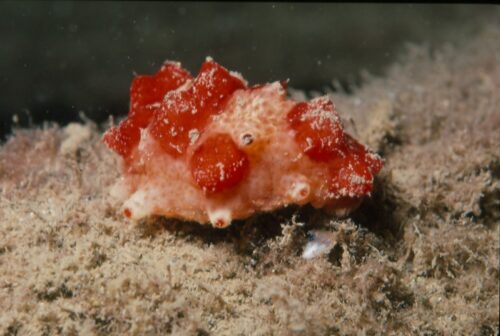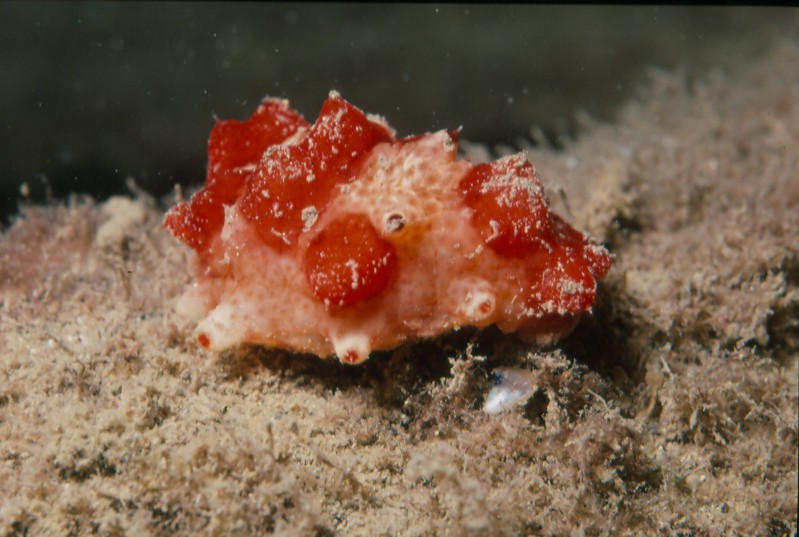David Muirhead wrote a report for our September 2002 newsletter about some of his dives at Port Lincoln in 2002. Part of All the Way with Port Lincoln Jetty described David’s discovery of a sea cucumber that appeared to be the rarely sighted Pentacta anceps.

“(this jetty was a cucumber paradise) …. I did two under (Port Lincoln jetty) 12th and 14th June (2002) and I’m happy to report that these also were a photographic bonanza. On the first dive (both had 7 metres viz., ….. I hit the jackpot, finding a holothurian which I’d never seen before, crawling over an old piece of jetty crossbeam lying on the bottom.
It was about 9cm long and from a distance I first thought it was a big nudibranch. Covered as it was with knobby red tubercles, which meant it could not possibly be a Ceratosoma brevicaudatum, I fancied I had discovered a new species. On closer inspection, my excitement subsided, albeit only fractionally. ….. Given the absence of gill apparatus, and the array of little pseudopods, I realised I was looking at a remarkably pretty sea cucumber.
A few fin strokes away I found another, but these were the only two I saw. I found none at all on the second dive two days later when I specifically searched, hoping for the perfect photo in more relaxed circumstances. I’m reasonably sure after book perusal that these are Pentacta anceps, the aptly named Candy-striped Holothurian.”

David posted a photo of his 2007 sighting on iNaturalist in 2021. It still hasn’t been identified at this stage (2/6/23). I have now suggested Pentacta anceps as being the species concerned, just to get some debate on the identification of the species.
There have only been two observations of Pentacta anceps reported on iNaturalist so far. Both reported sightings are from WA -one at the ex-BHP Bulk Jetty, Riseley Rd, Kwinana Beach in 2020 and one from the CBH Kwinana Grain Terminal in 2021. These sites are reasonably close to each other.
Photos of Pentacta anceps on iNaturalist can be found at https://www.inaturalist.org/taxa/737439-Pentacta-anceps/browse_photos .
I asked the question “What is the difference between Pentacta anceps and Cercodemas anceps?” On iNaturalist.
One identifier of one photo as being that of Pentacta anceps commented, “I am not sure, but I don’t know that Pentacta is the correct genus… so withdrawing ID completely.” Another person was tagged into the conversation, and that person suggested that Colochirus crassus may be the species in question. See the ‘Update’ below.
(There have only been four reported sightings of Colochirus crassus on iNaturalist, all in WA. All four were made in the past three years, three of them earlier this year (2023).)
UPDATE:
As can be seen further below in David’s comments – “Steve, on iNat I’ve flagged for curation the question of what if any difference there is between the two anceps taxa.
I’ve viewed the single (apart from mine which remains tentative) P. anceps observation from near Fremantle and the roughly 45 observations of C.anceps which have an essentially tropical to subtropical Indopacific distribution. It seems likely that the 2 taxa are synonymous but I certainly don’t know!
I’d love to revisit the Port Lincoln public jetty next warm season hoping to find more of these, take better photos and ideally collect a specimen for an Australian museum.
And FWIW I still haven’t located my few other photos of the same individual from Port Lincoln and the other photos I took of the 2nd one there. But I know that neither displayed any feeding behaviour; they were dormant at the time, and the 2nd one (from memory) looked almost moribund and was probably senescent.
Consistent with the likelihood that whatever the correct species label, this is a warm water animal which (before global warming) would have had only a seasonal occurrence at SA’s Gulf ports.
(And until further records arise, we should assume that remains the case. But I think it likely further records will soon occur here in SA and elsewhere along southern Australian coasts).”
and
“Steve, The curator said that the original reference for Pentacta anceps is no longer available and the species is not recognised on wORMs*.”
* (World Register of Marine Species)
“He thinks probably it was a synonym for C.anceps, and I agree.
As for the last sea cucumber you mentioned (Colochirus crassus?), with 4 inat Australia observations, I don’t even want to go there! Too hard for amateur me.”
So, it now seems that we are looking at Cercodemas anceps here, rather than Pentacta anceps, which wORMS says “is no longer available” and “is not recognised on wORMs”. Pentacta anceps was a probably asynonym for Cercodemas anceps.
Further, the remaining iNaturalist post of Pentacta anceps has been changed to Cercodemas anceps, now being called the Pink Warty sea cucumber. Pentacta anceps is said to now be an Inactive Taxon.


Thanks Steve.
Steve, on inat I’ve flagged for curation the question of what if any difference there is between the two anceps taxa.
I’ve viewed the single (apart from mine which remains tentative) P. anceps observation from near Fremantle and the roughly 45 observations of C.anceps which have an essentially tropical to subtropical Indopacific distribution. It seems likely that the 2 taxa are synonymous but I certainly don’t know!
I’d love to revisit the Port Lincoln public jetty next warm season hoping to find more of these, take better photos and ideally collect a specimen for an Australian museum.
And FWIW I still haven’t located my few other photos of the same individual from Port Lincoln and the other photos I took of the 2nd one there. But I know that neither displayed any feeding behaviour; they were dormant at the time, and the 2nd one (from memory) looked almost moribund and was probably senescent.
Consistent with the likelihood that whatever the correct species label, this is a warm water animal which (before global warming) would have had only a seasonal occurrence at SA’s Gulf ports.
(And until further records arise, we should assume that remains the case. But I think it likely further records will soon occur here in SA and elsewhere along southern Australian coasts).
Steve,
The curator said that the original reference for Pentacta anceps is no longer available and the species is not recognised on wORMs. He thinks probably it was a synonym for C.anceps, and I agree.
As for the last sea cucumber you mentioned, with 4 inat Australia observations, I don’t even want to go there!
Too hard for amateur me.